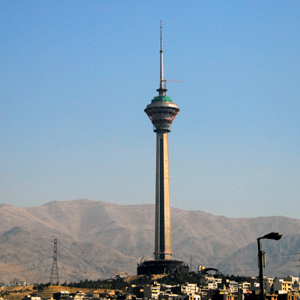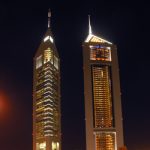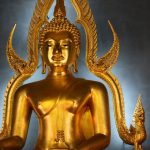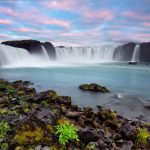 Just down the street from where the Ayatollah Khomeini’s simple house stands in a leafy northern suburb of Tehran, someone had scrawled the following on a wall: ‘America: there is not a damn thing you can do!’ It was spray painted in English. Elsewhere, I spotted large murals depicting skulls on the American flag with the words “Down with the USA!” across it. Also in English. None of this came as a shock to me; in fact I expected to see such banners, but when I actually stood there looking at them I realized something. I realized that, other than the Cuban government, I have not witnessed another government so obsessively preoccupied with verbalizing its opposition to America among its constituents as the one of Iran. I certainly have visited other countries whose governments have less than cordial ties to the USA, but with none of this widespread hostile propaganda. It almost seemed like a sheep bleating from behind a barbed wire fence.
Just down the street from where the Ayatollah Khomeini’s simple house stands in a leafy northern suburb of Tehran, someone had scrawled the following on a wall: ‘America: there is not a damn thing you can do!’ It was spray painted in English. Elsewhere, I spotted large murals depicting skulls on the American flag with the words “Down with the USA!” across it. Also in English. None of this came as a shock to me; in fact I expected to see such banners, but when I actually stood there looking at them I realized something. I realized that, other than the Cuban government, I have not witnessed another government so obsessively preoccupied with verbalizing its opposition to America among its constituents as the one of Iran. I certainly have visited other countries whose governments have less than cordial ties to the USA, but with none of this widespread hostile propaganda. It almost seemed like a sheep bleating from behind a barbed wire fence.
But if you can look beyond the repressive regime and their corrupt policemen, the country is absolutely lovely and steeped in thousands of years of history. Traveling by modern transport diminished my sense of space and history a little and I had to constantly remind myself that those plains and mountain ranges of northern Iran which I passed by bus have been trod upon at least for the last 6000 years of recorded history. And likely much earlier before that. Standing next to a timeless mud brick dwelling on the northern fringes of the Dasht-e-kafir (desert of infidels) I imagined Alexander the Great leading his men east toward the Oxus River and then, 1500 years later, Genghis Khan pushing his Mongol hordes westward. Throughout this trip I come across these historical figures and, despite their murderous aims, I can’t help but admire the hardiness required to cross these rugged lands of mountains, deserts, and endless plains.
 And then there are those Aryans again. I’m not talking about the distorted “master race” diatribe promoted by Nazism, but the tribes that originated several thousand years ago from somewhere in Central Asia and/or the Caucasus and gave rise to the people of Iran, Afghanistan, Kashmir, and northern India. All of them are speakers of the Indo-European family of languages, which range from Hindi and Farsi to Greek, Slavic, Romance, and Germanic. In fact, the modern name “Iran” is a cognate of the ancient word “Aryan”. Tied into my fascination with this Central Asian history is also the ancient religion of Zoroastrianism, whose fire temples the current Islamist mullahs have not been able to stamp out. Living deep under cover, there are thought to be a few hundred thousand practitioners in Iran. I always thought of them as fire worshippers until I actually met an authentic Zoroastrian in Mashhad, one of the holiest cities of the Islamic Shias. He explained to me that yes, they pray in front of a fire or other source of light, but it is done in the same manner that Christians pray in front of a crucifix. Their object of worship is also a monotheistic God, who, this man went as far to claim, gave rise to the Abrahamic religions of Judaism, Christianity and Islam.
And then there are those Aryans again. I’m not talking about the distorted “master race” diatribe promoted by Nazism, but the tribes that originated several thousand years ago from somewhere in Central Asia and/or the Caucasus and gave rise to the people of Iran, Afghanistan, Kashmir, and northern India. All of them are speakers of the Indo-European family of languages, which range from Hindi and Farsi to Greek, Slavic, Romance, and Germanic. In fact, the modern name “Iran” is a cognate of the ancient word “Aryan”. Tied into my fascination with this Central Asian history is also the ancient religion of Zoroastrianism, whose fire temples the current Islamist mullahs have not been able to stamp out. Living deep under cover, there are thought to be a few hundred thousand practitioners in Iran. I always thought of them as fire worshippers until I actually met an authentic Zoroastrian in Mashhad, one of the holiest cities of the Islamic Shias. He explained to me that yes, they pray in front of a fire or other source of light, but it is done in the same manner that Christians pray in front of a crucifix. Their object of worship is also a monotheistic God, who, this man went as far to claim, gave rise to the Abrahamic religions of Judaism, Christianity and Islam.
Other than harboring undercover Zoroastrians, the city of Mashhad, located in northeastern Iran’s Khorasan region, calls itself home to the mausoleum of Imam Reza. As a descendant of the Islamic prophet Muhammad, as a martyr, and as a leader of the Shias, the dominant sect of Islam in Iran, he got his own mausoleum around which the city has been built. Over the centuries this complex has grown in size, so that it now covers many acres clad in white marble and domes and minarets decked out in the most intricate geometric patterns imaginable. After Mecca and Medina, this is the third most visited shrine of the Islamic world and the first time I set foot into such a place. I expected to be searched for weapons but I didn’t expect to be asked about my religious status. I must have looked obviously foreign and possibly “infidel”, so the guard inquired whether I am a Muslim or not. Non Muslims aren’t even allowed inside, so the answer was obvious.
 Once inside, there are a few acres of a marble clad plaza to be covered before I could get anywhere near the golden domed mausoleum itself. From the blinding gleam I realized that those domes are covered in real gold and so is much of the wall space between the tile work.
Once inside, there are a few acres of a marble clad plaza to be covered before I could get anywhere near the golden domed mausoleum itself. From the blinding gleam I realized that those domes are covered in real gold and so is much of the wall space between the tile work.
And I hadn’t gone inside yet. The crowds became ever denser as I approached the main building and trying to get in you had to let yourself get swooped up by the slowly moving mass of humanity. Personal space dropped to zero; men surrounded me so completely, that I could feel breathing and chanting all around me. In rhythmical fashion someone would chant a mournful line about the Imam’s martyrdom and the immediate crowd responded with a heavy collective sigh. Once pushed and carried through several halls separated by massive wooden doors, the heart of this mausoleum revealed itself under a huge domed ceiling covered in crystal and gold: a truck size rectangular cage with a gilded roof and wrought bars of silver. Green prayer flags hung from the roof gables. The chanting turned into an emotional frenzy as men threw themselves at the cage and tried to touch it. I presume the actual tomb must have been underneath and this was a protective structure. Getting back out took just as long as getting inside, as almost everyone stopped to kiss one of the several massive doors.
I wouldn’t say this was an experience I would like to repeat over and over, but it was interesting to mingle in a group so entranced and so full of religious conviction.
The Alborz mountain range rises sharply from the central plains along the northern edge of the country and then falls off again toward the Caspian Sea, with the 18400 foot Damavand volcano as its highest point. Somewhat unexpectedly for Iran, this region boasts the best skiing in the entire Middle East, even though I would consider this area more part of the Caucasus than the Middle East proper. Heading north out of Tehran I spotted multiple ski lifts on verdant slopes idly waiting for the winter months.
 Leaving Tehran became an issue of necessity for me after two days well spent in some of the most polluted air imaginable. Like most large Asian cities I have visited, Tehran attracts many people from economically disadvantaged rural areas, who then contribute to urban sprawl, unchecked growth, and unbreatheable air. While there, I imagined to encounter an interesting mix of people and their costumes, since the 12 million or so residents hail from all over the country. But it turned out that the “komitee”, the much feared secret police of the mullah regime had done a great job of subduing people, especially women, into wearing drab, almost uniform like clothing. Men had it easier and got away with mostly dark western style slacks and button down shirts, but not too colorful. Women, on the other hand, seemed to be relegated to long pants and the ubiquitous black head scarf worn over a black coat which came down to about mid thigh or lower. Wearing flashier colors or shorter coats certainly raised the ire of the “komitee”, who, I found out, led a major crackdown earlier this year on the dressing habits that pushed the envelope too much. Hundreds of women were arrested and arbitrarily jailed for supposed transgressions of the “Islamic dress”. Out in the countryside an all encompassing black veil that only exposes the face appeared to be the norm. With such a young population, I am curious how much longer Iranians will put up with such repression. While the men loved political discourse, no one, however, dared to openly criticize the Ahmadinejad administration or the supreme Ayatollah. It all seems to simmer underneath, waiting for the right time.
Leaving Tehran became an issue of necessity for me after two days well spent in some of the most polluted air imaginable. Like most large Asian cities I have visited, Tehran attracts many people from economically disadvantaged rural areas, who then contribute to urban sprawl, unchecked growth, and unbreatheable air. While there, I imagined to encounter an interesting mix of people and their costumes, since the 12 million or so residents hail from all over the country. But it turned out that the “komitee”, the much feared secret police of the mullah regime had done a great job of subduing people, especially women, into wearing drab, almost uniform like clothing. Men had it easier and got away with mostly dark western style slacks and button down shirts, but not too colorful. Women, on the other hand, seemed to be relegated to long pants and the ubiquitous black head scarf worn over a black coat which came down to about mid thigh or lower. Wearing flashier colors or shorter coats certainly raised the ire of the “komitee”, who, I found out, led a major crackdown earlier this year on the dressing habits that pushed the envelope too much. Hundreds of women were arrested and arbitrarily jailed for supposed transgressions of the “Islamic dress”. Out in the countryside an all encompassing black veil that only exposes the face appeared to be the norm. With such a young population, I am curious how much longer Iranians will put up with such repression. While the men loved political discourse, no one, however, dared to openly criticize the Ahmadinejad administration or the supreme Ayatollah. It all seems to simmer underneath, waiting for the right time.









I enjoy reading your journals very much.